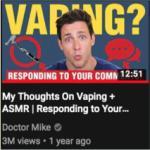Strategy 5: Use Innovative Outreach
Finding Effective Outreach Channels
Even the best programming won’t reach people without the right outreach, and companies have spent inordinate amounts of time learning what appeals to the young adult demographic. Title V can learn from what other organizations have already done to get this population’s attention.
With the prevalence of social media, effectively reaching many groups of young adults requires an online presence. At the same time, organizations may have limited digital marketing expertise or bandwidth. Thus, Title V programs are encouraged to work with partners on outreach. For example, a local university may vastly expand your state program’s reach online by posting Title V content to its Instagram account.
To promote Title V work, states can: 1) take a behind-the-scenes role by providing content that partners publicize using the strategies below, and/or 2) conduct outreach themselves through Title V channels. Whichever route your organization takes, this section offers guidance for reaching YAs. It places an emphasis on digital platforms, with principles that are also relevant for traditional media.

✔ Aim to Amuse
Highly successful outreach to young adults often uses playful, interactive messaging. For example, Rhode Island’s health insurance exchange, HealthSourceRI, launched a “Nag Tool Kit” teaching parents of young adults to use social media and dating apps like Snapchat and Tinder to encourage their children to sign up for insurance. This campaign reached many entities, even gaining positive promotion through local news outlets, due to its novel approach. To gain young adults’ attention, organizations can apply principles similar to those used by HealthSourceRI.

1. Design Outreach to be Interactive: By having YAs’ parents be the ones to share the importance of getting insured, HealthSourceRI started a dialogue between young adults and their loved ones. Other tactics for interactive outreach include inviting YAs to share content with friends and promoting content submitted by Title V participants.
2. Use Culturally Relevant Humor: Part of the success behind the Nag Tool Kit was the humor of seeing your parents on a dating app. Through community partners, states can consider using culturally appropriate humor to increase YA engagement. Consulting with a youth advisory board or focus group of young adults can help partners ensure culturally relevant content.
✔ Develop a Digital Audience
Organizations have both free and paid options to reach young adults digitally. In order to build an audience organically – meaning without paying to promote your content – it’s helpful to keep up with changes in algorithms for social media platforms like YouTube, Instagram and Twitter. Algorithms are the rules used by platforms to decide which posts get seen by users, and in what order. They impact what content gets shown to the most people, and criteria change regularly.
Posting frequency is one metric that has increased in importance over time, with social media marketers suggesting that people post at least once per day for best results.15 While community partners or Title V programs will likely choose to post less frequently than this, they can still benefit from a regular posting schedule.

Timing also plays a role in getting content seen: the best times to post on Facebook, for example, are Mondays- Wednesdays at around 12pm ET.16 Posting at this time can be a simple way to increase the number of people you reach. And interacting with other users by following their social media accounts, or liking, commenting on or sharing their posts can all increase the likelihood that one’s own posts will be shown to those users or to others in their network.
Thus, to increase the number of young adults and YA serving professionals that see your content, some of the first steps Title V partners and/or programs can take are to:
1) Post regularly
2) Post at peak times
3) Interact with other accounts that have shared interests
For Title V programs looking for further strategies to increase one’s digital audience, one method is to partner with social media influencers, who are individuals with large followings on digital platforms. Title V programs can narrow down potential partners by choosing social media influencers who have an audience that your state wants to reach (ex.: partnering with a female health & wellness Instagram influencer in your state to promote preconception care).
↑ (back to top)
 Dr. Michael Varshavski, known as Doctor Mike on social media, is a family medicine doctor who shares content about health and nutrition. He has tackled topics such as mental health, vaping and marijuana. His YouTube videos regularly get millions of views. Dr. Michael Varshavski, known as Doctor Mike on social media, is a family medicine doctor who shares content about health and nutrition. He has tackled topics such as mental health, vaping and marijuana. His YouTube videos regularly get millions of views. |
Working with social media influencers enables Title V programs to expand their reach to an audience that someone has already built, and convey important public health information through a voice that young adults trust.
✔ Take Ads for a Test Drive

Paid advertising, whether through traditional media or online sources, ensures that one’s message is put in front of people. But ads can feel like a questionable investment without evidence of their effectiveness. How do you know how many people you’ve reached and if you’re reaching your intended audience? Are people taking action based on your ads? Thankfully, there are multiple ways to get answers to these questions. Title V partners and/or agencies may want to consider the following opportunities, listed on the next page, to test drive advertising and ensure their resources are put to good use.
- Brainstorm with stakeholders: Young adults should be involved in the creation of outreach materials, which can start with brainstorming initial ideas or sharing drafts with YAs for feedback. Where relevant, healthcare providers can also provide important input on messaging for Title V services.
- Promote multiple versions of ads to a small audience: After vetting a couple variants of ads with stakeholders, test them on a small scale. This can be done by posting paper fliers with tear-off tabs in select locations or adding links to print advertising and seeing which links get the most hits.
On social media, similar tests can be done by restricting an ad’s target market to adults aged 18-24 in a small geographic area. All major social media platforms provide statistics on the number of people who have clicked one’s ad, which can then be used to measure the ad’s effectiveness in reaching the target audience.

After determining the ads that are most effective at engaging young adults, organizations can roll out the most popular advertisements on a larger scale. A combination of engaging content, digital marketing best practices and test piloting will help increase young adults’ awareness of health services and information they can use to live a healthier life.→ next: Lessons Learned
← previous: Strategy 4: Create Young Adult Targeted Programs
 University of California San Francisco
University of California San Francisco
